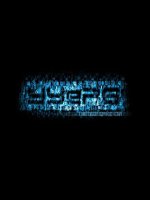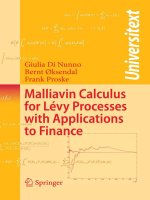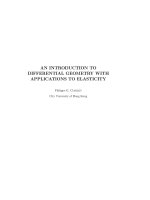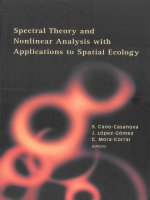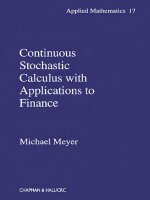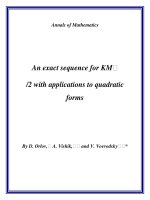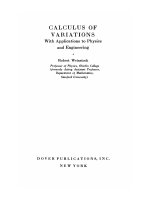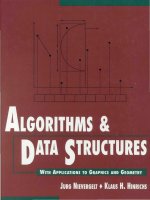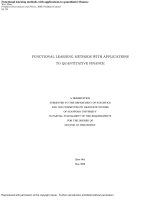Algorithms and data structures with applications to graphics and geometry
Bạn đang xem bản rút gọn của tài liệu. Xem và tải ngay bản đầy đủ của tài liệu tại đây (14.2 MB, 365 trang )
All
A
I'
I
rrL
v
g
S
I
3
Ii
p
1
p
I 1,
:
I$',i,.d]'
]1,
I
1
1'
ALGORITHMS
AND
DATA
STRUCTURES
With
Applications
to
Graphics and
Geometry
JURG
NIEVERGELT
ETH
Zurich
KLAUS
H.
HINRICHS
University
of
Miinster
PRENTICE
HALL,
Englewood
Cliffs,
New
Jersey
07632
Library
of
Congress
Cataloging-in-Publication
Data
NIEVERGELT, JURG.
Algorithms and data
structures:
with applications to
graphics and
geometry
/
Jurg
Nievergelt, Klaus Hinrichs.
p.
cm.
Includes
bibliographical
references and indexes.
ISBN 0-13-489428-6
1.
Computer
algorithms.
2.
Computer
structures (Computer
science)
3.
Computer
graphics.
1.
Hinrichs,
Klaus.
11.
Title.
QA76.9.A43N54
1993
005.1-
-
dc2O
92-4687
CIP
Acquisitions
editor:
Marcia
Horton
Prepress
buyer:
Linda
Behrens
Production
editor:
Jennifer
Wenzel
Manufacturing
buyer:
Dave Dickey
Copy
editor:
Barbara Zeiders Supplements
editor: Alice
Dworkin
Cover
designer:
Miguel
Ortiz
Editorial
assistant:
Dolores
Mars
=
1993
by
Prentice-Hall,
Inc.
A
Simon
&
Schuster
Company
I=
Englewood
Cliffs, New
Jersey
07632
The
author
and
publisher
of
this
book
have used
their
best
efforts
in
preparing this
book.
These
efforts
include the
development,
research,
and testing
of
the
theories
and programs
to
determine
their
effectiveness.
The author
and
publisher
make
no
warranty
of
any kind,
expressed
or
implied,
with
regard
to
these programs
or
the
documentation contained
in
this
book.
The author
and
publisher
shall
not
be
liable
in
any
event
for
incidental
or consequential
damages
in
connection
with, or arising out
of,
the
furnishing,
performance, or
use
of
these
programs.
All rights
reserved.
No
part
of
this
book
may
be
reproduced,
in
any form
or by
any
means,
without permission
in
writing
from
the
publisher.
Printed
in the
United
States
of
America
10
9
8
7
6
5
4
3
2
1
ISBN
0-13-489428-6
Prentice-Hall International
(UK)
Limited,
London
Prentice-Hall
of
Australia
Pty.
Limited, Sydney
Prentice-Hall Canada
Inc.,
Toronto
Prentice-Hall Hispanoamericana,
S.A.,
Mexico
Prentice-Hall
of
India Private Limited,
New
Delhi
Prentice-Hall
of
Japan,
Inc.,
Tokyo
Simon
&
Schuster
Asia
Pte.
Ltd.,
Singapore
Editora Prentice-Hall
do
Brasil,
Ltda.,
Rio
de
Janeiro
for
Tess
and Katharina
Contents
PREFACE
Part
I
Programming
environments
for
motion,
graphics,
and
geometry
1
REDUCING
A TASK
TO
GIVEN
PRIMITIVES:
PROGRAMMING
MOTION
1.1
A
robot
car,
its
capabilities,
and
the task
to
be
performed
3
1.2
Wall-following
algorithm
described
informally
5
1.3
Algorithm
specified
in
a
high-level
language
6
1.4
Algorithm
programmed
in
the
robot's
language
6
1.5
The
robot's
program optimized
7
2
GRAPHICS
PRIMITIVES
AND
ENVIRONMENTS
2.1
2.2
2.3
Turtle
graphics:
A
basic
environment
9
QuickDraw:
A
graphics toolbox
12
A
graphics
frame
program
15
xiii
1
3
9
V
2.4
Example
of
a
graphics
routine:
Polyline
input
18
3
ALGORITHM
ANIMATION
20
3.1
Computer-driven
visualization:
Characteristics
and
techniques
20
3.2
Example: The
convex
hull
of
points
in
the
plane
22
3.3
A
gallery
of
algorithm snapshots
24
Part
II
Programming
concepts:
Beyond
notation
31
4
ALGORITHMS
AND
PROGRAMS
AS
LITERATURE:
SUBSTANCE
AND
FORM
32
4.1
Programming
in
the large
versus
programming
in
the
small
32
4.2 Documentation
versus
literature:
Is it
meant
to
be
read?
33
4.3
Pascal
and its dialects:
Lingua franca
of
computer
science
39
5
DIVIDE-AND-CONQUER
AND
RECURSION
44
5.1
An
algorithmic
principle
44
5.2
Divide-and-conquer
expressed
as
a
diagram:
Merge
sort
45
5.3
Recursively
defined trees
46
5.4 Recursive
tree
traversal
48
5.5
Recursion
versus iteration: The
Tower
of
Hanoi 49
5.6 The
flag
of
Alfanumerica:
An
algorithmic
novel
on
iteration
and
recursion
52
6
SYNTAX
54
6.1
Syntax and
semantics
54
6.2
Grammars
and
their
representation:
Syntax
diagrams
and
EBNF
55
6.3
Example: Syntax
of
simple
expressions
57
vi
Contents
6.4
An overly
simple
syntax
for
simple
expressions
59
6.5
Parenthesis-free notation for
arithmetic
expressions
60
7
SYNTAX
ANALYSIS
63
7.1
The role
of
syntax
analysis
63
7.2
Syntax analysis
of
parenthesis-free expressions
by
counting
64
7.3
Analysis
by
recursive
descent
66
7.4
Turning syntax
diagrams
into
a
parser
66
Part
III
Objects,
algorithms,
programs
69
8
TRUTH
VALUES,
THE
DATA
TYPE
'SET',
AND
BIT
ACROBATICS
71
8.1
Bits
and
boolean
functions
71
8.2
Swapping
and
crossovers:
The
versatile exclusive-or
72
8.3
The
bit
sum
or
"population
count"
73
9
ORDERED SETS
81
9.1
Sequential
search
82
9.2
Binary
search
83
9.3
In-place
permutation
86
10
STRINGS
93
10.1
Recognizing
a
pattern
consisting
of
a
single
string
93
10.2
Recognizing
a
set
of
strings:
A
finite-state-machine
interpreter
94
11
MATRICES
AND GRAPHS:
TRANSITIVE
CLOSURE
99
11.1
Paths
in
a
graph
99
11.2
Boolean matrix
multiplication
100
11.3
Warshall's
algorithm
102
11.4
Minimum spanning
tree
in
a
graph
104
Contents
vii
12
INTEGERS
107
12.1
Operations
on
integers
107
12.2
The
Euclidean
algorithm
110
12.3
The
prime
number
sieve
of
Eratosthenes
111
12.4
Large
integers
112
12.5
Modular
number
systems: The
poor
man's
large
integers
113
12.6
Random numbers
116
13
REALS
119
13.1
Floating
point
numbers
119
13.2
Some
dangers
121
13.3
Homer's
method
123
13.4
Bisection
124
13.5
Newton's
method
for computing
the
square
root
125
14
STRAIGHT
LINES
AND
CIRCLES
129
14.1
Intersection
129
14.2
Clipping
132
14.3
Drawing
digitized
lines
134
14.4
The riddle
of
the
braiding straight
lines
137
14.5
Digitized
circles
142
Part
IV
Complexity
of
problems
and
algorithms
147
15
COMPUTABILITY
AND
COMPLEXITY
148
15.1
Models
of
computation:
The
ultimate RISC
148
15.2
Almost
nothing
is
computable
152
15.3
The
halting problem
is
undecidable
153
15.4
Computable,
yet
unknown
154
15.5
Multiplication
of
complex
numbers
156
vill
Contents
15.6
Complexity
of
matrix
multiplication
157
16
THE
MATHEMATICS
OF ALGORITHM ANALYSIS
161
16.1
Growth
rates and
orders
of
magnitude
161
16.2
Asymptotics
163
16.3
Summation
formulas
164
16.4
Recurrence
relations
166
16.5
Asymptotic
performance
of
divide-and-conquer
algorithms
169
16.6
Permutations
170
16.7
Trees
171
17
SORTING
AND
ITS COMPLEXITY
174
17.1
What
is
sorting?
How difficult
is
it?
174
17.2
Types
of
sorting
algorithms
177
17.3
Simple
sorting
algorithms that
work
in
time
0(n
2
)
180
17.4
A
lower
bound
Q(n
logn)
181
17.5
Quicksort
183
17.6
Analysis
for
three
cases:
best,
"typical,"
and
worst
186
17.7
Merging
and
merge sorts
188
17.8
Is it
possible
to
sort
in
linear
time?
191
17.9
Sorting networks
192
Part
V
Data
structures
197
18
WHAT
IS
A
DATA
STRUCTURE?
199
18.1
Data
structures old
and
new
199
18.2
The range
of
data
structures
studied
201
18.3
Performance
criteria
and
measures 202
19
ABSTRACT
DATA
TYPES
204
19.1
Concepts:
What
and
why?
204
Contents
ix
Contents
19.2
Stack
206
19.3
First-in-first-out
queue
210
19.4
Priority
queue
212
19.5
Dictionary
213
20
IMPLICIT
DATA
STRUCTURES
218
20.1
What
is
an
implicit data
structure?
218
20.2
Array storage
219
20.3
Implementation
of
the
fixed-length
fifo
queue
as
a
circular
buffer
224
20.4
Implementation
of
the
fixed-length
priority queue
as
a
heap
227
20.5
Heapsort
232
21
LIST
STRUCTURES
234
21.1
Lists, memory
management,
pointer
variables
234
21.2
The
fifo
queue
implemented
as
a one-way
list
237
21.3 Tree
traversal
238
21.4
Binary
search trees
248
21.5
Balanced
trees:
General
definition
252
21.6
Height-balanced
trees
254
21.7
Multiway
trees
260
22
ADDRESS
COMPUTATION
267
22.1
Concepts
and terminology
267
22.2
The
special
case
of
small key
domains
269
22.3
The
special
case
of
perfect
hashing:
Table
contents
known
a
priori
269
22.4
Conventional
hash
tables:
Collision
resolution
271
22.5
Choice
of
hash
function:
Randomization
276
22.6
Performance
analysis
278
22.7
Extendible
hashing
279
X
22.8
A
virtual
radix
tree:
Order-preserving
extendible
hashing
281
23
METRIC
DATA
STRUCTURES
284
23.1
Organizing
the
embedding
space
versus organizing
its
contents
284
23.2
Radix
trees, tries
285
23.3
Quadtrees
and
octtrees
286
23.4
Spatial data
structures:
Objectives and
constraints
288
23.5 The grid
file
290
23.6
Simple geometric objects
and
their
parameter
spaces
294
23.7
Region
queries
of
arbitrary
shape
296
23.8
Evaluating
region queries
with
a
grid
file
298
23.9
Interaction
between
query
processing
and
data
access
298
Part
VI
Interaction
between
algorithms
and
data
structures:
Case
studies
in
geometric
computation
303
24 SAMPLE
PROBLEMS
AND ALGORITHMS 305
24.1
Geometry
and
geometric
computation
305
24.2
Convex
hull:
A
multitude
of
algorithms
307
24.3
The
uses
of
convexity: Basic operations
on
polygons
311
24.4 Visibility
in the plane: A
simple algorithm
whose
analysis
is
not
314
25
PLANE-SWEEP:
A
GENERAL-PURPOSE
ALGORITHM
FOR
TWO-DIMENSIONAL
PROBLEMS
ILLUSTRATED
USING
LINE
SEGMENT
INTERSECTION
321
25.1
The line segment intersection
test
321
25.2
The
skeleton:
Turning
a
space
dimension
into
a
time
dimension
323
Contents
xi
25.3
Data
structures
324
25.4 Updating the
y-table
and detecting
an
intersection
325
25.5
Sweeping across
intersections
325
25.6 Degenerate
configurations,
numerical
errors,
robustness
326
26
THE
CLOSEST
PAIR
PROBLEM
329
26.1
The
problem
329
26.2 Plane-sweep applied
to the
closest pair
problem
330
26.3
Implementation
332
26.4
Analysis
334
26.5
Sweeping
in three
or
more dimensions
335
REFERENCES
338
INDEX
Ali
Contents
343
Preface
This
book
aims
to
be a
challenging introduction
to
computer
science
of
unconventional
coverage
and
style.
Let
us
explain
its
prerequisites and
aims,
so
that
the
reader
may
judge
whether
it
matches
his
or
her
background
and
goals.
This
is
not
a
beginner's
introduction
to
programming.
We
assume
that
the
reader
has
mastered
a
high-level programming
language
and can use
it
to
express
any
algorithm
that
he
or
she
understands thoroughly.
As
a
consequence
of
this
point
of
view,
we
present
program fragments
in
an
open-ended,
extended dialect
of
Pascal
which
is
not
defined
formally.
We
rely
on
readers to
translate
these
constructs
into
a
programming
language
of
their
choice.
We
do
not
aim
at
a
comprehensive
coverage
of
introductory
computer
science,
nor
even
a
balanced
one.
We
focus
on
themes
that
lead
the
student rapidly
to important
concepts,
insights,
and
techniques
in
a
few
core areas
of
computer
science.
Even
though
we
regard
computer
science
as
the
technology
of
formalization,
we
rarely
present
our
topics
in
a
formal
manner.
In
an
age
of
computers,
formal presentation
is
suited primarily
for
interaction
with machines,
not
for
communication between
people.
The
student's
first
encounter
with
an
idea
is
more fruitful
if
the
presentation
appeals
to
his
or
her
intuition,
and
this
is
best achieved
by
packaging
the
idea
in
a
telling
example.
We
often
leave to the
reader
the
task
of
generalizing
the
jist
of
an
example
into
a
general
rule.
Creating
a
program
leads
the
student
to
express formally not
just
the
example, but
the general
rule,
and
thus
to
practice
the craft
of
formalization.
xiii
Selecting
problems
and
algorithms
from
many
different
domains
at
times
precludes
presenting
the
background
that
may
be
necessary
for
full
understanding.
This
is
the
case,
for
example,
in
our
brief
introduction
to
computability.
We
base
this
choice
on
the
ra-
tionale
that
important,
difficult
topics
cannot
be
conquered
in
one
charge
but
must
be
attacked
in
consecutive
waves,
each
of
which
penetrates
more
deeply
into
the
subject.
And
that
an
early
first
exposure
facilitates
mastery
when
the
student
faces
these
funda-
mental
topics
in
more
depth
later
in
the
curriculum.
After
all
these
warnings
about
what
this
book
is
not,
let
us
address
the
question
of
what
it
aims
to
be.
First,
we
want
to
convince
the
self-taught
computer
fan,
who
"knows
all
about
programming",
that
computer
science
has
developed
powerful
ideas,
not
easily
reinvented,
that
can
be
turned
directly
into
tools
for
developing
good
programs.
Second,
we
wish
to
show
the
beginning
student
and
future
computer
scientist
a
sample
of
the
intellectual
demands
required
by
a
CS
curriculum,
to
avoid
confusing
computer
science
with
hacking.
Third,
we
aim
to
achieve
these
goals
by
presenting
issues
and
results
of
lasting
value,
with
ideas
that
we
hope
will
outlive
the
current
generation
of
computers,
operating
systems,
and
programming
languages.
Our
expectation
of
the
half-life
of
a
topic
has
often
decided
the
question
of
whether
it
ought
to
be
included.
The
future
will
show
whether
we
have
guessed
wisely.
Let
us
motivate
our
choice
of
topics.
In
Part
I,
"Programming
Environments
for
Motion,
Graphics,
and
Geometry",
we
assume
that
the
reader
has
worked
with
one
or
two
computers,
operating
systems,
and
languages,
and
may
now
have
to
master
a
new
programming
environment
that
supports
graphics.
We
use
this
opportunity
to
reinforce
the
idea
that
programming
is
the
reduction
of
a
conceived
solution
to
given
primitive
operations,
and
hence
that
it
is
largely
inde-
pendent
of
any
specific
environment.
We
begin
by
defining
a
toy
environment
designed
to
set
the
tone
and
highlight
simple
concepts
necessary
for
programming
motion,
geom-
etry,
and
graphics.
Next,
we
ask
the
questions:
What
programming
environment
would
we
like
to
have,
what
are
we
likely
to
find,
and
what
can
we
do
to
narrow
the
gap?
Recognizing
the
fact
that
most
of
today's
programs
are
interactive
but
that
programming
techniques
for
interaction
are
not
widely
taught,
we
devote
a
section
to
dialog
control
and
show
examples
of
algorithm
animation
techniques
in
action.
This
leads
us
to
develop
in
Part
II,
"Programming
Concepts:
Beyond
Notation"
an
open-ended
dialect
of
Pascal
and
to
build
reusable
program
modules
that
will
ease
the
programming
task
throughout
the
course.
In
order
to
get
started
right
away
on
interesting
and
attractive
demo
programs,
we
review
recursion-recursive
pictures
make
beautiful
examples
of
algorithm
animation.
Throughout
the
book
we
take
a
cavalier
attitude
toward
issues
of
syntax,
reserving
the
right
to
modify
syntactic
definitions
on
the
spur
of
the
moment.
This
is
not
the
message
inculcated
into
novices-namely,
that
every
semicolon
matters-but
it
comes
naturally
to
one
who
understands
thoroughly
how
syntax
is
processed.
To
breed
this
familiarity
with
syntactic
issues
that
allows
us
to
ignore
syntax
and
to
focus
on
semantics,
we
devote
two
sections
to
syntax
definition
and
analysis.
All
in
all,
Part
II
is
a
potpourri
of
programming
topics
selected
to
wean
beginning
students
away
from
a
specific
system
they
have
learned,
and
to
drive
home
the
idea
that
most
programming
issues
are
"beyond
notation."
xiv
Preface
Part
III,
"Objects,
Algorithms, Programs",
builds
up a
collection
of
problems
and
algorithms that
use
a
variety
of
data types
and
arise
in
many applications.
This
is
the
raw
material
that
serves
to
introduce the student, gradually,
to
the
theory
of
algorithm
design
and
analysis.
We
use
the
following
selection
criteria:
1.
The
problems
must
be
real,
that
is, a
practical
programmer
is
likely
to
face
many
of
them
sooner
or
later;
they
can
be
stated concisely and
clearly, and
the
requirements
for
a
solution
are
also
clear.
In
other
words,
we
have selected hard
problems
rather
than
soft
ones.
2.
The
algorithms
are
chosen for
their
elegance, efficiency,
and conciseness; wher-
ever
possible,
we
have
tried
to
build
in an
element
of
surprise,
something to be
discovered,
something
more
than
meets
the
eye.
3.
These
algorithms
require only
the
simplest
of
data
structures-arrays.
More
elab-
orate
data
structures
are
introduced
in
Part
V,
and
used
to
good
effect
in
Part
VI.
Our
emphasis
on
real
problems
leads
us
to
present
examples
of
numerical
difficul-
ties
to
a
greater
depth
than
is
usual
in
an
introductory
text-such
as
the
phenomenon
of
the
braiding straight
lines.
Throughout
Part
III
we
introduce
by
example
the
basic
concepts
and
techniques
of
complexity
theory:
choice
of
primitive operations, counting
of
operations, asymptotic
techniques
and notation.
Part
IV,
"Complexity
of
Problems
and
Algorithms",
is
background
material
for
a
systematic
treatment
of
complexity.
Starting
with
an
intuitive
introduction to
com-
putability
and
its
refinement, the
notion
of
complexity,
we
survey the
mathematical tools
commonly
used
in
algorithm
analysis.
We
illustrate
the use
of
these tools
by
presenting
classical
results
on
sorting,
an
important
topic
in
its
own
right.
Part
V,
"Data
Structures",
introduces
the
concept
of
abstract data
type
as
a
tool
to
separate
functional
specification
and
implementation;
we
discuss advantages and
short-
comings
of
this
formal
approach. Each
of
the
following
sections
presents
a
different type
of
data
structures:
implicit,
lists,
address computation.
We
use
this
variety to
illustrate
radically
different
implementations
of
(almost) the same
abstract
data
types:
to
make
the
point
that
different contexts favor different
implementations
of
the same
functional
specification.
In
contrast
to
many books
on
data
structures
which emphasize
lists
and
comparative
search
techniques,
we
attach
equal
importance
to
address
computation
and
metric
data
structures
that
partition
space
according
to
predefined
grids.
Part
VI,
"Interaction Between Algorithms
and
Data
Structures: Case
Studies
in
Geometric Computation"
has
a
threefold
goal.
First,
we
want
to
show
convincingly
that
the
data
structures
of
Part
V
can
make
a
difference:
They
are
essential to
the
efficiency
of
most
of
the
algorithms
presented
here.
Second, after
touching
briefly on
many
algorithms
from different
subject
areas, we
wish
to
present
in
greater
depth one
coherent
area
where
a
particular
type
of
algorithm,
plane-sweep,
is
used
in
many
versions.
Third,
we
provide
an
introduction
to
a
novel
and
increasingly important discipline
in
computer
science:
efficient and
robust
geometric computation.
This
broad
collection
of
fundamental computer
science
topics
may
be
too
much
for
any
one course.
As
a
help
to
the
reader
and
instructor
in
selecting
a
subset suitable
to
his
Preface
xv
or
her
purpose,
here
is
the
dependency structure
of
the
various
parts
of
the
book.
Parts
I,
II,
and
III
form
the
"elementary
half'
of
the
book, Parts
IV,
V,
and
VI
the
"advanced
half'.
"Elementary"
and
"advanced"
refer
to
mathematical prerequisites, not necessarily
to the
intellectual
difficulty
of
the topic.
In
the
first
half
we
have
collected
challenging
topics
that
we
feel
can
be
understood
on the
basis
of
high
school
mathematics,
whereas
the
second
half
makes
extensive
use
of
the
"mathematics
of
algorithm analysis", summarized
in
Chapter
16.
Parts
I,
II,
and
III
are
independent
of
each
other.
The
second
half of
the
book
assumes
a
technical maturity
that
is
typically acquired through familiarity of
problems
and
techniques
similar
to
those
of
the
first
half,
but
does
not
assume
explicit
knowledge
of
precisely
those topics
treated
in
the
first half.
Thus
a
traditional course
on
data
structures
for
students who have taken
one or two introductory courses
in
computer
science
might
be
based
on
Chapters
16
to
26,
with Chapters
I
to
15
serving
as
a
source
of
exercises,
programming
projects,
and
applications.
Exercises
and
examples
are
sprinkled throughout
the
text,
some
with
solutions,
some
without.
A
generic
exercise
and
programming project
that
applies
to
almost
any
topic
treated
in
this book
is
to
program
and animate
the
execution
of
some
algorithm
on
a
sample
data
configuration.
To
acquaint the
student
early
with the necessary concepts
and
techniques, Part
I
is
dedicated
to
graphics programming,
and
Chapter
3
in
particular
to
algorithm
animation.
Exercises
at the
end
of
each
chapter
can
generally
be
solved
in
a
straightforward
manner
by
analogy with
the
ideas
of
that
chapter.
Parts
of
this
text
are
based
on
our book
Programmierung
und
Datenstrukturen
(Springer-Verlag,
1986),
but the
coverage has
been
greatly
expanded
and
revised.
We
have
developed
this
material over
the years
in
a
number
of
courses,
ranging
from intro-
ductory
computer
science
to
computational geometry,
given
at
the
Swiss
Federal Institute
of
Technology,
ETH
Zurich;
the
University
of
North Carolina
at
Chapel
Hill;
the
Uni-
versity
of
Siegen, Germany;
and
the
University
of
Munster, Germany.
We
gratefully
acknowledge
the
helpful
contributions
of
former
and
present
students
and
colleagues
in
all
of
these
places: in
particular, David
Banks,
Kim
Blakeley, Christian Brechbuehler,
Herbert
Ehler,
Feiga
Heymann,
Jonathan
Hexter, Anders Kierulf, Ulrich Marburger,
Carlo Muller,
Jan Prins,
Peter
Schorn,
John
A.
Smith,
and
Don
Stanat.
Our
thanks
go
to
those
who
reviewed
the text,
particularly,
Professor
Andrew Bernat
of
the
University
of
Texas
at
El
Paso,
Professor
Arunabhasen
of
Arizona
State
University,
and
Professor
Mario
Gerla
of
the
University
of
California
at
Los
Angeles. Finally,
we
thank
the
entire
team
at
Prentice
Hall
for
their
understanding, cooperation
and
great
patience.
Jurg
Nievergelt
and
Klaus
Hinrichs
Zvi
Preface
PART
I
PROGRAMMING
ENVIRONMENTS
FOR
MOTION,
GRAPHICS,
AND
GEOMETRY
Artificially
simple
programming
environments.
Program design.
Informal
versus
formal
notations.
Reducing
a
solution to
primitive
operations.
Programming as an
activity
independent
of
language.
The
Purpose
of
an
Artificial
Programming Environment
A
program
can
be
designed
with
the barest
of
tools,
paper
and
pencil,
or
in
the
programmer's
head.
In
the
realm
of such informal
environments,
a
program
design
may
contain
vague
concepts expressed
in
an
informal notation.
But
before
she
can
execute this
program,
the
programmer needs
a
programming
environment,
typically
a
complex
system
with
many
distinct
components:
a
computer
and
its
operating
system,
utilities,
and
program
libraries;
text
and
program
editors;
various
program-
ming
languages
and
their
processors.
Such
real
programming
environments force
programmers
to
express
themselves
in
formal
notations.
Programming
is
the
realization
of
a
solution
to
a
problem,
expressed
in
terms
of
those operations
provided
by
a
given
programming
environment.
Most
programmers
work
in
environments that
provide
very
powerful
operations
and
tools.
The
more
powerful
a
programming environment,
the
simpler the programming
task,
at
least
to
the expert
who
has
achieved
mastery
of
this environment.
But
even
an
experienced
programmer
may
need
several
months to
master
a
new
pro-
gramming
environment,
and
a
novice
may
give
up
in
frustration
at
the multitude
of
concepts
and
details
he
must
understand
before
he
can
write
the
simplest
program.
The
simpler
a
programming
environment,
the
easier
it is
to
write
and
run
small
programs,
and
the
more
work
it is
to write
substantial,
useful
programs.
In
the
early
days
of
computing, before
the
proliferation
of
programming
languages
during
the
1960s,
most
programmers worked
in
environments that
were
exceedingly
sim-
1
pie
by
modern
standards:
Acquaintance
with
an
assembler,
a loader,
and
a
small
program
library sufficed.
The
programs
they
wrote were small
compared
to
what
a
professional
programmer
writes
today.
The
simpler
a
programming
environment
is,
the
better suited
it
is
for
learning
to
program. Alas,
today
simple environments
are
hard
to
find!
Even
a
home
computer
is
equipped
with
complex
software
that
is
not
easily
ignored or
bypassed.
For
the
sake
of
education
it
is
useful to
invent
artifi-
cial programming
environments.
Their
only purpose
is
to
illustrate some
important
concepts
in
the
simplest
possible setting
and
to
facilitate
insight.
Part
I
of
this
book
introduces
such
a
toy
programming
environment
suitable
for
programming
graphics
and
motion,
and
illustrates
how
it
can
gradually
be
enriched
to approach
a
simple
but useful
graphics
environment.
Textbooks
on
computer graphics.
The
computer-driven
graphics
screen
is
a
powerful
new medium
for
communication. Visualization
often
makes
it
possible
to
present
the results
of
a
computation
in
intuitively
appealing
ways
that
convey
insights
not
easily
gained
in
any other
manner.
To
exploit this
medium,
every
programmer
must
master
basic
visualization
techniques.
We
refer
the
reader
interested
in
a
systematic
introduction
to
computer graphics
to
such
excellent
textbooks
as
[BG
89],
[FDFH
90],
[NS
79],
[Rog
85], [Wat
89],
and
[Wol 89].
I
CHAPTER
1
Reducing
a
Task
to
Given
Primitives:
Programming
Motion
Primitives
for
specifying
motion.
Expressing
an
algorithm
in
informal
notations
and
in
high-
and
low-level
programming
languages.
Program
verification. Program optimization.
1.1
A
ROBOT
CAR,
ITS
CAPABILITIES, AND
THE
TASK TO
BE
PERFORMED
Some
aspects
of
programming
can be
learned
without
a
computer,
by
inventing
an
artificial
programming environment
as
a
purely
mental exercise.
The
example
of
a
vehicle
that
moves
under program
control
in
a
fictitious
landscape
is
a
microcosmos
of
programming
lore.
In this
section
we
introduce
important
concepts that
will
reappear
later
in
more
elaborate
settings.
The
environment. Consider
a
two-dimensional
square grid,
a
portion
of
which
is
enclosed
by a
wall
made
up
of
horizontal
and
vertical
line
segments
that
run
halfway
between
the
grid
points
(Fig.
1.
1).
A
robot
car
enclosed within
the
wall
moves
along
this
grid
under computer
control,
one
step
at
a
time, from
grid
point
to
adjacent
grid point.
Before
and
after each step, the
robot's
state
is
described
by a
location (grid
point)
and
a
direction
(north, east, south,
or
west).
3
Reducing
a
Task
to
Given
Primitives: Programming
Motion Chap.
1
I
W
E
,
p
l l l l
S
7 r-l-r-~-n-~-7-i-r-
H I ^ 4 '-
Figure
1.1
The
robot's
cross-hairs
show
its
current location
on
the
grid.
The
robot
is
controlled
by
a
program that
uses
the
following
commands:
left
Turn
90
degrees
counterclockwise.
right
Turn 90
degrees clockwise.
forward Move one
step,
to
the
next
grid
point
in
front
of
you.
goto
#
Send
program
control
to the label
#.
if
touch
goto
#
If
you
are
touching
a
wall
to
your
front,
send
program control
to
the
label
#.
A
program for
the
robot
is a
sequence
of
commands
with
distinct
labels. The
labels
serve
merely
to
identify
the
commands
and
need
not
be
arranged
either consecutively
or
in
increasing
order.
Execution
begins with
the
first
command
and
proceeds
to successive
commands
in
the
order
in
which
they
appear,
except
when
flow
of
control
is
redirected
by
either
of
the
goto
commands.
Example
The following program
moves
the
robot
forward
until
it
bumps
into
a
wall:
I
if
touch goto
4
2
forward
3
goto
1
4 {
there
is
no
command
here;
just
a
label
}
In developing programs
for
the
robot, we
feel free
to use
any
high-level
language
we prefer,
and
embed robot commands
in
it.
Thus
we
might
have
expressed
our
wall-
finding
program
by
the simpler
statement
while
not touch
do
forward;
and then
translated
it
into the
robot's
language.
A
program
for this
robot
car
to
patrol
the
walls
of
a
city
consists
of
two
parts:
First,
find
a
wall, the
problem
we
just
solved.
Second, move
along
the
wall
forever
while
maintaining
two
conditions:
4
Sec.
1.2
Wall-following
Algorithm
Described
Informally
1.
Never
lose
touch with
the
wall;
at
all
times,
keep
within
one step
of
it.
2.
Visit every spot
along
the
wall
in
a
monotonic progression.
The
mental
image
of
walking around
a
room
with
eyes closed,
left
arm
extended,
and
the
left hand
touching
the
wall
at
all
times will
prove
useful.
To
mirror
this
solution
we
start the
robot
so
that
it
has
a
wall on
its
immediate
left
rather
than
in
front.
As
the
robot
has no
sensor
on
its
left
side,
we
will
let it
turn
left
at
every
step to
sense
the wall
with
its
front bumper,
then
turn
right
to
resume
its
position
with the
wall
to
its
left.
1.2
WALL-FOLLOWING
ALGORITHM
DESCRIBED
INFORMALLY
Idea
of
solution:
Touch
the
wall with
your
left
hand;
move forward, turning
left
or
right
as
required
to
keep touching
the
wall.
Wall-following
algorithm
described
in
English:
Clockwise, starting
at
left,
look
for
the first
direction not blocked
by
a
wall,
and
if
found,
take
a
step
in
that
direction.
Let
us
test this algorithm
on
some
critical
configurations. The
robot
inside
a
unit
square
turns
forever,
never
finding
a
direction
to
take
a
step
(Fig.
1.2).
In Fig.
1.3
the
robot
negotiates
a
left-hand
spike.
After
each
step,
there
is a
wall to
its
left-rear.
In
Fig.
1.4
the
robot
enters
a
blind
alley.
At
the
end
of
the
alley,
it
turns
clockwise
twice,
then
exits
by
the
route
it
entered.
Figure
1.2
Robot
in
a
box spins
on
its
heels.
Figure
1.3
The
robot
turns
around
a
spike.
Figure
1.4
Backing
up
in
a blind
alley.
5
Reducing
a
Task
to Given Primitives:
Programming
Motion
Chap.
1
1.3
ALGORITHM
SPECIFIED
IN
A
HIGH-LEVEL LANGUAGE
The ideas
presented informally
in
Section
1.2
are
made
precise
in the
following
elegant,
concise
program:
{
wall
to
left-rear
}
loop
{
wall
to
left-rear
]
left;
[
wall
to
left-front)
while
touch
do
{
wall
to
right-front)
right;
{
wall
to
left-front }
endwhile;
[
wall
to
left-front )
forward;
[
wall
to
left-rear)
forever;
[
wall
to
left-rear
}
Program
verification.
The
comments
in
braces
are
program
invariants:
asser-
tions
about
the
state
of
the
robot
that
are
true
every
time
the
flow
of
control
reaches
the
place
in
the
program
where they
are written.
We
need three types
of
invariants
to
verify the
wall-following program
"wall
to
left-rear",
"wall to left-front",
and
"wall to
right-front".
The
relationships between
the
robot's
position
and the
presence
of
a
nearby
wall
that
must
hold
for
each
assertion to
be
true
are
illustrated
in
Fig.
1.5.
Shaded
circles
indicate
points through
which
a
wall
must
pass.
Each
robot
command
transforms
its
pre-
condition
(i.e.,
the assertion
true
before the
command
is
executed)
into
its
postcondition
(i.e.,
the
assertion
true
after
its
execution). Thus each
of
the
commands
'left',
'right',
and
'forward'
is a
predicate
transformer,
as
suggested
in
Fig.
1.6.
A-
Figure
1.5
Three
types
of
invariants
wall
to
left-rear
wall
to
left-front
wall to
right-front
relate the
positions
of
robot
and
wall.
1.4
ALGORITHM
PROGRAMMED
IN
THE
ROBOT'S
LANGUAGE
A
straightforward translation from
the
high-level
program
into
the
robot's
low-level
language yields
the
following
seven-line
wall-following
program:
6
Sec.
1.5
The
Robot's
Program
Optimized
loop
left;
while
touch
do
right;
endwhile;
forward;
forever;
2
3
4
5
6
7
left
if
touch
goto
4
goto
6
right
goto
2
forward
goto
I
I
I
wall
to
left-rear
4
-
-I
wail
to
right-front
wall
to
left-front
left
wall
to
left-front
right
C
wall
to
left-front
forward
l
wall
to
left-rear
Figure
1.6
Robot
motions
as
predicate transformers.
1.5
THE
ROBOT'S
PROGRAM
OPTIMIZED
In
designing
a
program
it
is
best to follow simple,
general
ideas,
and to
decide
on
details
in
the
most straightforward
manner,
without regard
for the many
alternative
ways
that
are
always
available
for
handling
details. Once
a
program
is
proven
correct,
and
runs,
then
we
may
try
to
improve
its
efficiency,
measured
by
time
and
memory requirements.
This process
of
program
transformation
can
often
be
done
syntactically, that
is,
merely
by
considering
the
definition
of
individual statements, not
the
algorithm
as
a
whole.
As
an
example,
we
derive
a
five-line
version
of
the
wall-following program
by
transforming
the
seven-line
program
in
two
steps.
If
we
have the
complementary primitive
'if
not
touch goto
#',
we can
simplify
the
flow
of
the
program
at the
left
as
shown
on
the
right
side.
[
wall
to
left-rear
}
left
if
touch
goto
4
goto
6
[
wall
to
right-front
}
right
goto
2
forward
goto
I
£ wall
to
left-rear
]
I
left
2
if
not
touch
goto
6
4
5
6
7
{
wall
to
right-front
}
right
goto
2
forward
goto
I
2
3
4
5
6
7
7
8
Reducing
a
Task to
Given Primitives: Programming
Motion
Chap.
1
An
optimization technique
called
loop
rotation
allows
us
to
shorten
this
program
by
yet
another
instruction.
It
changes
the
structure
of
the
program
significantly, as
we
see
from
the
way
the
labels have
been
permuted.
The assertion
"wall
to
right-front"
attached
to line 4
serves
as
an
invariant
of
the
loop
"keep
turning
right
while
you
can't
advance".
(
wall
to
right-front]
4
right
2
if
touch goto
4
6
forward
1
left
7
goto
2
PROGRAMMING
PROJECTS
1.
Design
a
data
structure suitable for storing
a
wall
made
up
of
horizontal and vertical line
segments
in
a
square
grid
of
bounded
size.
Write a
"wall-editor",
i.e.
an
interactive program
that
lets the
user
define and
modify
an
instance
of
such
a
wall.
2.
Program
the
wall-following algorithm
and
animate
its
execution
when
tracking
a
wall
entered
with the wall-editor.
Specifically, show the
robot's
position
and
orientation after
each
change
of
state.
CHAPTER
2
Graphics
Primitives
and
Environments
Turtle
graphics.
QuickDraw:
A
graphics
toolbox. Frame
program.
Interactive
graphics
input/output. Example:
Polyline
input.
2.1
TURTLE GRAPHICS:
A BASIC ENVIRONMENT
Seymour
Papert
[Pap
80]
introduced
the
term
turtle
graphics
to
denote
a
set
of
primitives
for
line
drawing.
Originally
implemented
in the
programming
language Logo,
turtle
graphics
primitives
are
now
available
for
several
computer
systems
and
languages.
They
come
in
different versions, but
the
essential
point
is
the
same
as
that
introduced
in the
example
of
the
robot
car:
The
pen (or
"turtle")
is
a
device
that
has
a
state
(position,
direction)
and
is
driven by
incremental operations
'move'
and
'turn'
that transform
the
turtle
to
a
new
state
depending
on
its
current
state:
move(s)
[
take
s
unit
steps
in the
direction
you
are
facing)
tum(d)
[
turn
counterclockwise
d
degrees
3
The
turtle's
initial
state
is
set
by
the
following
operations:
moveto(x,
y)
[
move
to
the
position
(x, y)
in
absolute
coordinates
}
turnto(d)
[
face
d
degrees
from
due
east
}
In
addition,
we
can
specify
the
color
of
the
trail drawn
by
the
moving
pen:
pencolor(c)
{
where
c =
white,
black, none, etc.
}
9
